Cultural & Culinary Experiences
Experience the sites, sounds, and tastes of the Philippines
Cultural
Tagaytay
All Tours
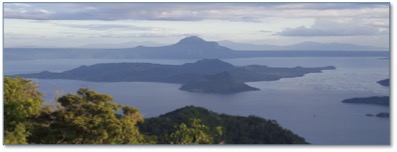
Tagaytay is a popular tourist destination in the Philippines, known for its cool climate, scenic views, and proximity to Manila. It is located in the province of Cavite, about 60 kilometers (around 1.5 hours) south of the capital.
Sitting at about 600–700 meters above sea level, Tagaytay enjoys a cooler climate than much of the lowland Philippines, making it a favourite weekend getaway spot.
Tagaytay is famous for its stunning view of Taal Volcano, one of the smallest active volcanoes in the world, located within Taal Lake. The sight from Tagaytay Ridge offers one of the most iconic natural landscapes in the Philippines.
Taal Lake
All Tours
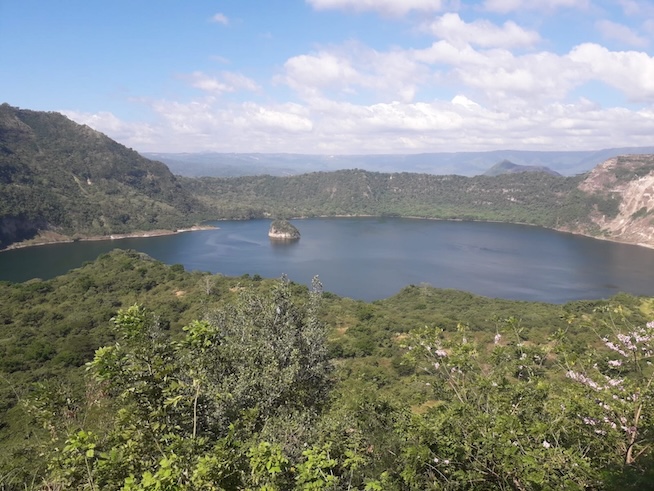
Taal Lake lies within a 25–30 km (16–19 mi) caldera formed by explosive eruptions between 140,000 and 5,380 years ago and has a depth of 172m.
Since the formation of the caldera, subsequent eruptions have created a volcanic island within the caldera, known as Volcano Island. This 5-kilometre (3.1 mi) island covers an area of about 23 square kilometres (8.9 sq mi) with the center of the island occupied by the 2-kilometre (1.2 mi) Main Crater with a single crater lake formed from the 1911 eruption. The Main Crater Lake on Volcano Island is the largest lake on an island in a lake on an island in the world. This lake contains Vulcan Point, a small rocky island inside the lake. After the 2020 eruption, the Main Crater Lake temporarily disappeared but had returned by March 2020.
Mount Pinatubo
Coastal & Island, and Ultimate North Luzon Loop
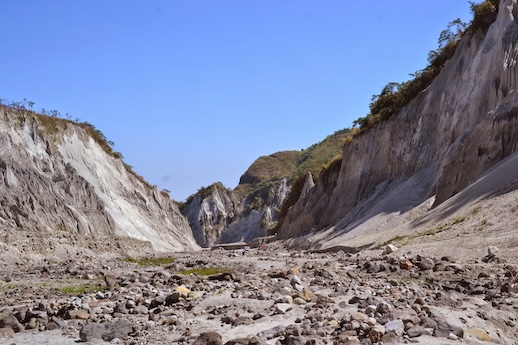
Although we don’t visit Mt Pinatubo we do ride over bridges that traverse the lahars created by the 1991 eruption.
Mount Pinatubo is an active stratovolcano located on the island of Luzon in the Philippines, at the intersection of the provinces of Zambales, Tarlac, and Pampanga. It is most famous for its catastrophic eruption on June 15, 1991, which was one of the largest volcanic eruptions of the 20th century.
Key Facts About Mount Pinatubo:
- Location: Luzon, Philippines
- Type: Stratovolcano
- Elevation: ~1,486 meters (4,875 feet) after the 1991 eruption (previously 1,745 meters or 5,725 feet)
- Notable Eruption: June 15, 1991
- Current Status: Active, but relatively quiet since its last activity in 1993
The 1991 Eruption:
The June 15, 1991 eruption was triggered by magma rising into the volcano, leading to an explosive eruption after centuries of dormancy. Key aspects of the eruption include:
Massive ash cloud
Lahars and pyroclastic flows
Global effects
Casualties and displacement
A large crater lake
The US military evacuated
Hundred Islands
Coastal & Island, and Ultimate North Luzon Loop

A rest day in Alaminos gives us the opportunity to explore some of the 123/4 islands of the Hundred Islands National Park
The Hundred Islands National Park is a famous island-hopping and eco-tourism destination in Alaminos, Pangasinan, Philippines. It consists of 124 islands at low tide and 123 at high tide, spread across 1,844 hectares in the Lingayen Gulf.
Key Facts About Hundred Islands
- Location: Alaminos, Pangasinan, Philippines
- Number of Islands: 124 (123 during high tide)
- Area: 1,844 hectares
- Established: 1940 (One of the Philippines’ oldest national parks)
- Governing Body: The City Government of Alaminos
Top Attractions & Activities
Island-Hopping
Snorkeling & Diving
Kayaking & Paddleboarding
Available in designated areas for a relaxing experience.
Cliff Jumping & Zip-lining
Wildlife & Nature Watching
Sagada
All Tours
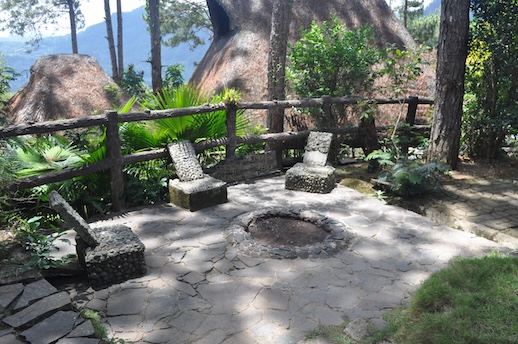
On all the tours we will have a rest day in Sagada giving you the opportunity to explore or visit some of the many places of interest in and around Sagada
Sagada is a tranquil mountain town located in the Mountain Province of the northern Philippines, famous for its cool climate, misty pine forests, and centuries-old hanging coffins on limestone cliffs. Nestled in the Cordillera Mountains, it’s a favorite destination for backpackers, nature lovers, and those seeking a peaceful escape from city life.
There are numerous cultural sites and activities to be found in Sagada and the surrounding area:
Buscalan Village - Apo Whang‑Od
Buscalan Village is a remote mountain community in Tinglayan, Kalinga Province, located in the Cordillera region of Northern Luzon, Philippines. Home to the Butbut tribe, it gained international attention as the setting of Apo Whang‑Od, the country’s most renowned traditional tattoo artist (mambabatok), born in 1917 and still practicing into her 100s
Banaue Rice Terraces
Banaue Rice Terraces are a breathtaking example of ancient agricultural engineering carved into the mountains of Ifugao Province in northern Luzon, Philippines. Often referred to as the “Eighth Wonder of the World“, these terraces were built over 2,000 years ago by the indigenous Ifugao people, and they remain one of the most iconic cultural landmarks in the country.
Hanging Coffins
Sagada Hanging Coffins are one of the most unique and haunting cultural practices in the Philippines—and a defining symbol of Sagada, located in the Mountain Province of the Cordillera region in northern Luzon. This ancient burial tradition involves placing the deceased in wooden coffins and hanging them on limestone cliffs, high above the ground.
What Are the Hanging Coffins?
- The coffins are mounted on cliff faces or tucked into rock crevices, especially around Echo Valley near the Sagada town center.
- Some coffins are perched hundreds of feet above the ground, while others are stacked or hung more accessibly along pathways.
- They are often hand-carved by the deceased or their family, using traditional pinewood.
Cultural and Spiritual Beliefs
- Practiced by the indigenous Kankanaey people, one of the Igorot groups of the Cordillera.
- The belief is that the higher the dead are placed, the closer they are to the spirit world or the afterlife.
- Hanging coffins also protect the bodies from floods, animals, and grave robbers.
Samaguing Caves
Sumaguing Cave—often called the “Big Cave“—is one of the most popular and awe-inspiring natural attractions in Sagada, Mountain Province. Known for its dramatic limestone formations, underground pools, and thrilling caving experience, it offers visitors a unique mix of adventure and natural beauty.
What Makes Sumaguing Cave Special
- It’s the largest and most accessible cave system in Sagada.
- Famous for its stunning rock formations, shaped over thousands of years by water and time.
- Locals refer to it as the “Cave of Wonders” due to its uniquely shaped stalactites and stalagmites that resemble animals, curtains, giant teeth, and even bacon strips.
The Cave Experience
- Guided tours only— all visitors are required to hire local guides through the Sagada Tourist Information Office.
- The descent involves slippery rocks, narrow crevices, cold water pools, and rope-assisted sections.
- Expect to crawl, squeeze, wade, and climb—this is not a walk in the park!
- Tours range from:
- Short Sumaguing Tour (~1.5–2 hours)
- Cave Connection Tour (3–4 hours) — starts at Lumiang Burial Cave and exits through Sumaguing.
Bomod-ok Falls
Bomod‑ok Falls – often called the “Big Falls” – one of Sagada’s most spectacular natural wonders:
- Approximately 200 feet (60 m)—making it one of the tallest waterfalls in the region with a powerful, straight cascade into a pristine pool.
- Known locally as the “Big Falls,” derived from the Kankanaey (Igorot) word “Bomod‑ok”, meaning big.
- A natural plunge pool at the base offers a chilling dip—refreshing after the hike, though the water is extremely cold and best enjoyed briefly.
The Trek Experience
- Trail: The trek starts at the jump-off point in Barangay Bangaan and descends through Fidelisan Village and rice terraces before reaching the falls. Return involves a strenuous uphill climb.
- Duration: Around 1–2 hours one way, depending on pace and trail conditions.
- Scenery: Along the way, you’ll pass coffee farms, traditional rice terraces, and serene mountain landscapes—an immersive cultural journey.
- Trail Conditions: About half the trail is paved or cemented; the rest may be steep and slippery. Hiking sticks are available from guides for free.
Booking & Costs
- Registration & Fees:
- Environmental/tourism fee: ₱50 ($1 US)
- Barangay fee: ~₱10 per person
- Guide fee: ₱500 per group (typically up to 10 people)
- Shuttle/van (Sagada to jump-off point): ₱500–650 round trip.
- Guide & Shuttle Arrangement:
- Book through Sagada Tourist Info Center or accredited agencies like BFTAMPGA or SaGGA
What to Bring & Timing Tips
- Essentials: Bring water, snacks, insect repellent, sunscreen, extra clothes (the temperature is cool and you may get wet), and waterproof bag.
- Clothing: Wear trekking shoes/sandals—waterproof or durable—preferably quick-dry gear.
- Season: Best visited during the dry season (November to April/May). Avoid the wet period (June–September) due to slippery trails and potential landslides. During harvest or ritual seasons, access may be restricted.
Local weaving
Sagada Weaving is a cultural treasure of Sagada, Mountain Province, and one of the oldest weaving enterprises in the Cordillera region. It is both a traditional craft and a thriving local industry that highlights the rich heritage of the Igorot people, particularly the Kankanaey of Sagada.
History and Origins
- Founded in 1968 by Andrea Bondad, a local teacher who wanted to preserve traditional weaving and provide livelihood to women in Sagada.
- Originally started as a small weaving room with a few handlooms; now it’s a respected name in Philippine indigenous textile production.
Weaving Traditions
- Sagada weaving uses backstrap and upright looms, traditional to the Cordillera.
- Patterns are geometric and symmetrical, passed down through generations.
- Designs are rich with symbolism, representing nature, daily life, and cultural beliefs of the Igorots.
- Weavers typically use cotton or polyester-blend threads, dyed in vibrant colors like red, blue, green, black, and yellow.
Products You Can Find
Sagada Weaving produces a variety of handcrafted items, including:
- Woven bags (shoulder, backpacks, wallets)
- Coin purses and pouches
- Table runners, placemats, and blankets
- Traditional garments like wanes (men’s loincloths) and lufid (women’s skirts)
Each piece is individually handmade, making it unique and deeply tied to local identity.
Visitor Experience
- The Sagada Weaving Workshop and Store is located just a few minutes’ walk from the town center.
- Visitors can:
- Watch weavers at work on traditional looms.
- Buy souvenirs directly from the source (supporting local livelihoods).
- Learn about the cultural importance of weaving in Sagada’s society.
Sagada Gin
Sagada Gin is a unique, small-batch craft gin made in Sagada, Mountain Province, and it stands out for its locally foraged botanicals and distinct Cordilleran character. It reflects not only a love for fine spirits but also a deep respect for the rich natural and cultural heritage of the Sagada region.
Key Botanicals
Sagada Gin uses a blend of traditional gin ingredients with native Cordilleran elements, such as:
- Juniper berries (as in all true gins)
- Sagada orange peel – citrusy and slightly bitter, from the region’s signature sweet oranges
- Lemongrass
- Sampaguita (Philippine jasmine)
- Siling labuyo (native chili) – for a hint of heat
- Cordillera pine and local herbs – evoking the scent of Sagada’s misty pine forests
These give the gin a floral, earthy, citrus-forward flavor with a subtle spicy finish.
Craft Distillation
- Produced in small batches to maintain quality and consistency.
- Uses a slow, vapor-infusion process, which extracts delicate flavors from the botanicals without overpowering the spirit.
- Bottled at around 45–47% ABV (varies slightly by batch), making it a strong but smooth spirit.
Vigan
All Tours
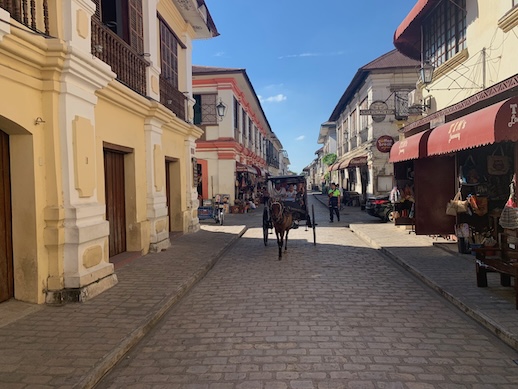
An overnight stay during the Coastal & Island and Ultimate North Luzon Loop tours and a rest day on the Mountain & Highlands Tour.
Vigan is a historic city in the Philippines known for its remarkably preserved Spanish colonial architecture and cobblestone streets. It is located in Ilocos Sur, on the northwestern coast of Luzon, and is the capital city of the province. Recognized as a UNESCO World Heritage Site in 1999, Vigan is one of the oldest towns in the Philippines, with a blend of Asian and European architectural and cultural elements.
Vigan offers a rare glimpse into the Philippine colonial past that feels frozen in time. It’s ideal for travelers interested in history, architecture, cultural heritage, and local cuisine.
Known for inabel weaving – a handwoven textile native to the Ilocos region and famous for furniture-making and antique woodwork. Vigan is also home to cultural festivals such as the Viva Vigan Binatbatan Festival of the Arts which is held every May.
Historical Significance:
- Founded in 1572 by Spanish conquistador Juan de Salcedo.
- Was a major trading post even before Spanish arrival, with strong ties to Chinese merchants.
- Played a key role during the Spanish colonial era as a center of governance and Catholic evangelization in Northern Luzon.
Top Attractions:
Calle Crisologo
A short but famous cobbled street lined with preserved Spanish-era mansions, antique shops, and horse-drawn carriages (kalesas).
Vigan Cathedral
St. Paul Metropolitan Cathedral – Built in the 1800s, this Baroque-style cathedral is a centerpiece of the city.
Plaza Salcedo
Bantay Bell Tower
Built in 1591 the Bantay Bell Tower offers panoramic views of the city and countryside; once used for monitoring the approach of invaders and has become a symbol of Vigan.
Syquia Mansion Museum
Former home of President Elpidio Quirino, showcasing Filipino-Spanish heritage and antiques.
Vigan Heritage Village
A walkable area where traditional architecture and local crafts thrive.
Pagburnayan Jar Factory
Demonstrates the traditional art of pottery-making, which Vigan is famous for.
Baguio
All Tours
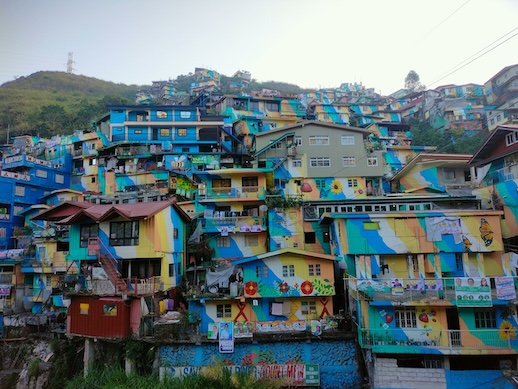
Baguio City, often called the “Summer Capital of the Philippines”, is a mountain city in northern Luzon known for its cool climate, pine forests, and vibrant arts and culture scene. Nestled in the Cordillera Central mountain range at about 1,540 meters (5,050 ft) above sea level, it’s a popular destination for both locals and tourists seeking relief from the lowland heat.
Baguio mixes colonial charm, mountain traditions, and modern city life—whether you’re drawn by the cool air, creative spirit, or indigenous culture, it’s a must-visit gem in northern Luzon.
Annual Events
- Panagbenga Festival (Flower Festival)– Held every February, features floral floats, street dancing, and city-wide celebrations.
- Session in Bloom– Post-Panagbenga market and food fair along Session Road.
Overview
- Location: Benguet Province, Cordillera Administrative Region
- Climate: Mild and temperate, with temperatures ranging from 13°C to 24°C
- Best Time to Visit: November to May (dry, cool season)
- Languages: Ilocano, Ibaloi, Tagalog, and English
Top Attractions:
Burnham Park
A historic park in the city center featuring a man-made lake, boat rentals, biking lanes, flower gardens, and picnic areas.
Mines View Park
Offers panoramic views of abandoned gold and copper mines and the Cordillera mountains; also known for souvenir stalls and photo ops with native attire.
The Mansion
Official summer residence of the Philippine President, with a grand gate and manicured lawns.
Wright Park
Famous for its Pool of Pines and horseback riding area—ideal for families and kids.
Botanical Garden
Lush with native flora and traditional Igorot huts, it highlights Baguio’s indigenous heritage.
Baguio Public Market
A must-visit for local delicacies like ube jam, fresh strawberries, walis tambo (soft brooms), and woven crafts.
Session Road
Baguio’s main commercial strip with restaurants, cafes, bars, and shops — great for walking and people-watching.
Tam-Awan Village
An artist village and cultural site that showcases Ifugao and Kalinga huts, local art, and Cordilleran traditions.
BenCab Museum
Founded by National Artist Benedicto Cabrera, it houses contemporary art alongside indigenous Cordilleran pieces, with scenic views of forest and foggy hills.
Baler
Mountain & Highlands and Ultimate North Luzon Loop
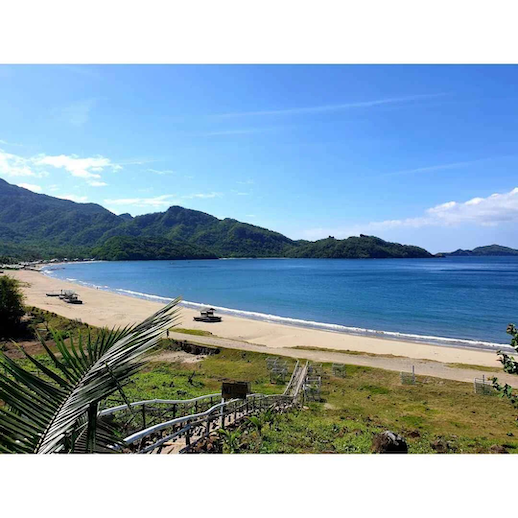
Baler is a coastal town in Aurora Province, eastern Luzon, known for its surfing waves, historical landmarks, and lush natural scenery—from waterfalls and mountain views to stunning sunrise beaches. It’s both a surfing mecca and a cultural heritage site, making it a favorite weekend getaway from Manila.
Quick Facts
- Location: Aurora Province, Central Luzon (facing the Pacific Ocean)
- Best time to visit: September to February for surfing; March to May for summer beach fun
- Languages: Tagalog, Ilocano, and English
- Famous for: Surfing, waterfalls, Spanish-era history, and scenic coastlines
- Siege of Baler (1898–1899): The site of a famous last stand by Spanish soldiers who held out for nearly a year in Baler Church, unaware Spain had already surrendered the Philippines. The church still stands and is a key heritage landmark.
Top Attractions:
Sabang Beach
Baler’s main beach and surfing hub. Ideal for beginners (surf lessons widely available). Beautiful sunrise views and laid-back seaside resorts
Cemento Beach & Reef
Advanced surfing spot with stronger Pacific swells. Less crowded but more challenging, also good for snorkeling and diving.
Ditumabo “Mother” Falls
140-foot waterfall in nearby San Luis, reached via a scenic 30-minute hike. Clear, cool pools perfect for swimming.
Ermita Hill
Historical evacuation site during the 1735 tsunami. Offers panoramic views of Baler Bay and surrounding mountains. Home to the “Tromba Marina” sculpture (commemorating tsunami survivors).
Museo de Baler
Small but informative museum on Baler’s colonial history, indigenous culture, and the Siege of Baler. Located beside the Aurora Quezon House.
Aurora Aragon Quezon Ancestral House
Birthplace of Aurora Aragon Quezon, wife of President Manuel Quezon. Preserved wooden house offering insights into local and national history.
Dicasalarin Cove
Hidden white-sand beach with dramatic cliffs (private access via reservation).
Aniao Islets
Rock formations off the coast great for photography.
Baler Hanging Bridge
A picturesque footbridge over the Tibag-Sabang River.
Caunayan Falls, Diguisit Falls
Smaller waterfalls ideal for a quick nature stop.
Aparri
Ultimate North Luzon Loop
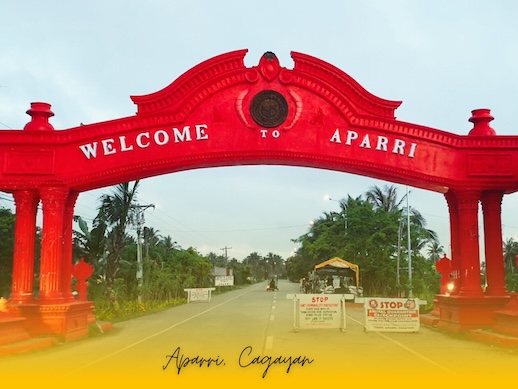
A rest day in Aparri gives you the opportunity to either chill-out by the pool (with a cold beer or two), or explore the surrounding area.
Aparri is a coastal municipality in Cagayan Province, located in the northernmost part of Luzon, Philippines. Known as the “Gateway to the Ilocos and the Pacific”, Aparri sits at the mouth of the Cagayan River, where it meets the Babuyan Channel of the Philippine Sea. It’s famous for its rich fishing grounds, strategic historical significance, and unique local delicacies.
Aparri was one of the earliest Spanish settlements in northern Luzon and played a key role in the Galleon Trade. Japanese occupation forces landed in Aparri in 1941. The area has a mix of Ibanag, Ilocano, and Spanish cultural influences.
Aparri offers a quieter, more authentic northern Luzon experience, rich in river culture, local traditions, and natural beauty—especially appealing for eco-tourists, cultural travelers, or those exploring the far north of the Philippines.
Key Facts
- Region: Cagayan Valley (Region II)
- Province: Cagayan
- Population: ~66,000 (as of 2020 census)
- Languages: Ibanag, Ilocano, Tagalog, English
Top Attractions:
Cagayan River
The largest and longest river in the Philippines flows into the sea at Aparri. Known for strong currents, rich fishing grounds, and historical trade access.
Aparri Delta and Mangroves
A critical ecosystem with mangrove forests and estuarine life. Great for birdwatching, boat rides, and eco-tours.
Fishing Industry
Aparri has a thriving fishing culture, especially for ludong, a rare and expensive freshwater fish. Other major catches include shrimp, crabs, and shellfish.
Aparri Port
Historically, this was an important Spanish-era port. Trade with China, Japan, and Southeast Asia passed through Aparri via the Cagayan River.
Aparri Park and Church
Historic church dedicated to the patron saint of fishermen, San Pedro Telmo. Central plaza with monuments and a relaxed provincial vibe.
Fuga Island
A secluded island with coral reefs and white sand beaches. Boat trips from Aparri can be arranged with local guides.
The boat trip takes approximately 2 hours and costs around p500. You can also rent a boat for P4000 to P5000 for a whole day.
Santa Ana
A 2.5hr ride from Aparri but Pozo Robo Beach makes the trip worthwhile.
Pagudpud
Ultimate North Luzon Loop
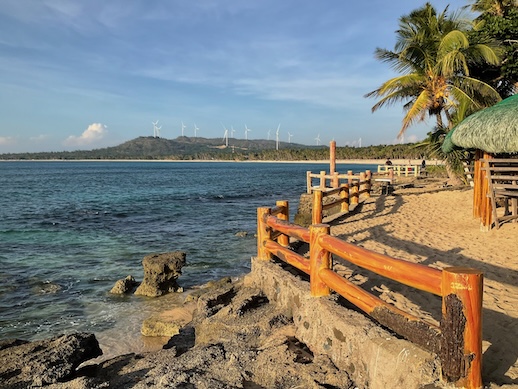
Pagudpud is a coastal resort town at the northern tip of Ilocos Norte, Philippines. Often called the “Boracay of the North”, it’s known for its white-sand beaches, crystal-clear waters, scenic coastal roads, and dramatic natural landscapes.
Top Attractions:
Saud Beach
Calm waters and golden-white sand ideal for swimming and sunset watching. Lined with small resorts and family-run inns.
Blue Lagoon (Maira-ira Beach)
A more rugged, photogenic beach known for turquoise waters, strong waves (great for surfing), and dramatic rock formations. Zipline available across the bay.
Kabigan Falls
A gentle 1.2-km hike through rice fields and forest leads to this beautiful 87-ft. waterfall with a cold, swimmable pool.
Patapat Viaduct
A picturesque coastal bridge that hugs the cliffs of the Cordillera Mountains — offering amazing views of Pasaleng Bay. Part of the Maharlika Highway.
Timmantang Rock & Bantay Abot Cave
Both are seaside rock formations shaped by wind and waves, offering great photo ops and local folklore.
Culinary
Philippine Traditional
Calderetta
Caldereta (sometimes spelled Kaldereta) is a popular Filipino stew known for its rich, tomato-based sauce and tender meat, often goat, beef, or chicken. It is influenced by Spanish cuisine and is commonly served at special occasions and gatherings.
Key Ingredients
- Meat – Traditionally goat meat, but beef, pork, or chicken can also be used.
- Tomato Sauce – Provides the stew’s rich, slightly tangy base.
- Liver Spread or Pâté – Adds depth and a creamy texture.
- Vegetables – Potatoes, carrots, bell peppers, and green peas.
- Spices & Seasonings – Garlic, onions, bay leaves, and sometimes chili for spice.
- Cheese (Optional) – Some versions include grated cheese for extra creaminess.
How It’s Cooked
The meat is typically browned, then simmered in a mixture of tomato sauce, broth, and spices until tender. Vegetables and liver spread are added towards the end to enhance the flavour.
Menudo
Menudo is a classic Filipino dish made with pork and liver stewed in a tomato-based sauce, often served with rice. It is different from the Mexican Menudo (which is a tripe soup) and is a staple in Filipino households, especially at gatherings and celebrations.
Key Ingredients
- Pork – Usually cut into small cubes.
- Liver – Adds a rich, slightly earthy flavor.
- Tomato Sauce – The base of the stew, giving it a tangy and slightly sweet taste.
- Vegetables – Potatoes, carrots, bell peppers, and sometimes green peas or raisins.
- Garlic & Onions – For aromatics and added depth.
- Soy Sauce & Fish Sauce – Used for seasoning in some variations.
How It’s Cooked
- The pork is sautéed with garlic and onions until browned.
- Tomato sauce and broth are added and simmered until the pork is tender.
The liver and vegetables are added last to avoid overcooking
Bicol Express
Bicol Express is a popular Filipino dish known for its rich, creamy, and spicy coconut sauce. It originates from the Bicol region, which is famous for its love of chili peppers and coconut-based dishes.
Key Ingredients
- Pork – Typically cut into small pieces.
- Coconut Milk & Coconut Cream – Gives the dish its rich, creamy texture.
- Chili Peppers (Siling Labuyo or Siling Haba) – Provides the signature heat.
- Shrimp Paste (Bagoong Alamang) – Adds a deep umami flavor.
- Garlic, Onion, and Ginger – For aromatics and added depth.
How It’s Cooked
- The pork is sautéed with garlic, onion, and ginger.
- Shrimp paste is added for a savory depth.
- Coconut milk is poured in, and the dish is simmered until the pork is tender.
- Chili peppers and coconut cream are added for heat and richness.
- The dish is simmered until thick and flavourful.
Kare Kare
Kare-Kare is a traditional Filipino dish known for its rich, thick peanut sauce. It is often made with oxtail, tripes, or pork and served with bagoong (fermented shrimp paste) on the side for added umami. This dish is commonly served at special occasions and gatherings.
Key Ingredients
- Meat – Oxtail, pork hock, beef tripe, or even seafood in some variations.
- Peanut Sauce – Made from ground peanuts or peanut butter, giving it a rich, nutty flavor.
- Vegetables – Eggplant, string beans, banana heart (puso ng saging), and pechay (bok choy).
- Annatto (Atsuete) Seeds – Used to give the dish its orange color.
- Garlic, Onion, and Ground Rice – Enhance the sauce’s texture and depth of flavor.
How It’s Cooked
- The meat is boiled until tender.
- The peanut sauce is prepared by sautéing garlic and onions, then adding peanut butter or ground peanuts.
- The cooked meat and broth are added to the sauce and simmered.
- Vegetables are added towards the end to keep them fresh and vibrant.
- The dish is served hot with bagoong (shrimp paste) on the side.
Chopsuey
Chopsuey is a popular stir-fried vegetable dish in Filipino cuisine, influenced by Chinese cooking. It consists of a mix of crisp, colorful vegetables, meat, and a thick, flavorful sauce. This dish is widely enjoyed for its versatility, as it can be made with different proteins and vegetable combinations.
Key Ingredients
- Vegetables – Cabbage, carrots, bell peppers, cauliflower, snow peas, and baby corn.
- Meat & Seafood – Chicken, pork, shrimp, or beef. Some versions also include liver.
- Garlic & Onion – For aromatics.
- Soy Sauce & Oyster Sauce – Provides a savory, umami flavor.
- Cornstarch Slurry – Used to thicken the sauce.
- Hard-Boiled Quail Eggs (Optional) – A common addition in Filipino-style Chop Suey.
How It’s Cooked
- The meat or seafood is sautéed with garlic and onion.
- Vegetables are added and stir-fried quickly to maintain their crisp texture.
- A sauce made from soy sauce, oyster sauce, and cornstarch slurry is poured in.
- The dish is cooked until the sauce thickens and coats the ingredients.
- It is served hot, often with steamed rice.
Beef Tapa
Beef Tapa is a popular Filipino dish made of thinly sliced beef that is marinated, then fried or grilled. It is often served as part of Tapsilog, a classic Filipino breakfast meal that includes tapa (beef), sinangag (garlic rice), and itlog (fried egg).
Key Ingredients
- Beef – Thinly sliced, usually sirloin or tender cuts.
- Soy Sauce – Adds saltiness and umami.
- Vinegar or Calamansi Juice – Provides a tangy contrast and helps tenderize the meat.
- Garlic – Enhances flavour.
- Sugar – Balances the salty and tangy flavors.
- Black Pepper – Adds mild heat.
How It’s Cooked
- Marinate the beef with soy sauce, vinegar, garlic, sugar, and black pepper. Let it sit for a few hours or overnight.
- Fry or Grill – The beef can be pan-fried until slightly crispy or grilled for a smoky flavor.
- Serve Hot – Typically paired with garlic rice, a fried egg, and sometimes a dipping sauce of vinegar with chili.
Adobo
Adobo is one of the most iconic and beloved Filipino dishes. It is a savory, tangy, and slightly sweet stew made by braising meat in a mixture of vinegar, soy sauce, garlic, bay leaves, and black peppercorns. The dish is known for its deep, well-balanced flavors and long shelf life due to the use of vinegar as a natural preservative.
Key Ingredients
- Meat – Chicken, pork, or a combination of both (sometimes beef, seafood, or even vegetables).
- Vinegar – Gives the dish its signature tanginess and acts as a preservative.
- Soy Sauce – Adds umami and a salty depth.
- Garlic – Infuses the dish with aromatic flavor.
- Bay Leaves & Black Peppercorns – Provide a warm, earthy taste.
- Sugar (Optional) – Some versions add a bit of sugar for a subtle sweetness.
How It’s Cooked
- The meat is marinated in soy sauce, vinegar, garlic, and spices.
- It is then browned in a pan to enhance its flavor.
- The marinade, along with additional water or broth, is added and simmered until the meat becomes tender.
- Some variations reduce the sauce to a thick, flavorful glaze.
- Adobo is best served with steamed rice and often tastes even better the next day as the flavours continue to develop.
Longganisa
Longganisa is a popular Filipino sausage known for its rich, flavorful taste. It is inspired by Spanish longaniza but has been adapted with local ingredients and seasonings. Filipino longganisa comes in many regional varieties, with different flavors, textures, and levels of sweetness or garlickiness.
Types of Filipino Longganisa
Longganisa is generally classified into two main types:
- Longganisang Hamonado (Sweet Longganisa) – Made with pork, sugar, and sometimes pineapple juice for a sweet flavor. Common in places like Pampanga.
- Longganisang De Recado (Garlic/Savory Longganisa) – More garlicky and salty, sometimes spicy, with no added sugar. Famous in Vigan (Ilocos Region) and Lucban (Quezon).
Key Ingredients
- Ground Pork (or chicken, beef, or even fish in some variations)
- Garlic – Gives a strong, aromatic flavor.
- Vinegar – Enhances taste and acts as a preservative.
- Soy Sauce or Salt – For seasoning.
- Pork Fat – For juiciness and flavor.
- Sugar (for sweet variants).
- Annatto (Atsuete) or Paprika – Adds color to some versions.
How It’s Cooked
- The meat is mixed with seasonings and left to marinate overnight.
- The mixture is stuffed into natural or synthetic casings.
- It is either fresh (uncured) or cured (smoked/dried for preservation).
When cooking, longganisa is typically simmered with a bit of water, allowing it to cook in its own fat as the water evaporates, then fried until browned.
Pansit
Pancit is a general term for Filipino noodle dishes, which have Chinese origins but have been adapted to local tastes. It is a staple in Filipino cuisine and is often served during birthdays and celebrations because noodles symbolize long life and prosperity.
Popular Types of Pancit
- Pancit Canton
- Stir-fried egg noodles with pork, shrimp, vegetables, and a savory soy-based sauce.
- Similar to Chinese Chow Mein but with a Filipino twist.
- Often garnished with calamansi (Filipino lime) for added tanginess.
- Pancit Bihon
- Uses thin rice noodles (bihon), stir-fried with soy sauce, vegetables, and meat or seafood.
- One of the most common pancit dishes in Filipino households and gatherings.
- Pancit Malabon
- Thick rice noodles topped with a rich, orange-colored seafood sauce made from shrimp broth, annatto (atsuete), and sometimes crab fat.
- Topped with shrimp, squid, boiled eggs, and chicharon (crispy pork cracklings).
- A specialty of Malabon City.
- Pancit Palabok
- Similar to Pancit Malabon but uses thinner rice noodles and a shrimp-based sauce.
Pinakbet
Pinakbet is a traditional Filipino vegetable dish from the Ilocos region, known for its bold flavors and nutritious ingredients. It is a stir-fried or stewed vegetable dish flavored with bagoong (fermented shrimp or fish paste), giving it a distinct umami taste.
Key Ingredients
- Vegetables:
- Bitter melon (ampalaya)
- Eggplant (talong)
- Okra
- String beans (sitaw)
- Squash (kalabasa)
- Tomatoes
- Bagoong – Usually bagoong isda (fermented fish paste) in Ilocano versions, but bagoong alamang (fermented shrimp paste) is also used in other regions.
- Pork (optional) – Some versions include crispy or sautéed pork belly for added richness.
- Garlic, Onion, and Ginger – Aromatics that enhance the dish’s depth of flavor.
How It’s Cooked
- Sauté garlic, onion, and tomatoes in oil.
- Add pork (if using) and cook until lightly browned.
- Pour in bagoong and stir to coat the ingredients with its umami-rich flavor.
- Add vegetables, starting with harder ones like squash, then softer ones like okra and eggplant.
- Simmer until tender but not overcooked to maintain texture.
Sinigang
Sinigang is a traditional Filipino soup or stew known for its savory-sour flavor. It is typically made with pork (sinigang na baboy), but variations include beef, shrimp, or fish. The dish is characterized by its tangy broth, which is usually flavored with tamarind (sampalok), though other souring agents like green mango, calamansi, or santol can be used.
Key Ingredients
- Protein: Pork (most common), beef, shrimp, or fish
- Souring Agent: Tamarind, green mango, calamansi, santol, or kamias
- Vegetables: Water spinach (kangkong), eggplant, radish, okra, string beans, and tomatoes
- Seasoning: Fish sauce (patis), salt, or soy sauce
How It’s Cooked
- The meat is boiled until tender.
- Tamarind (or another souring agent) is added for the signature tangy taste.
- Vegetables are added in stages to retain their texture.
- Seasoning is adjusted before serving.
Sisig
Sisig is a famous Filipino dish from Pampanga, known for its savory, tangy, and crispy flavors. Traditionally, it is made from grilled and chopped pork parts, especially the face (maskara) and ears, mixed with onions, chili peppers, and calamansi. Some variations include a raw egg or mayonnaise for added richness.
Origins of Sisig
Sisig was originally a Kapampangan dish dating back to the 1700s. The name comes from the old Kapampangan word “sisigan,” meaning “to make sour,” as early versions were pickled salads. The modern, sizzling version was popularized by Lucia Cunanan, known as “Aling Lucing,” in the 1970s.
Types of Sisig
- Classic Pork Sisig – Made with chopped pork face, ears, and liver.
- Chicken Sisig – Uses chopped grilled or boiled chicken.
- Bangus (Milkfish) Sisig – A healthier alternative with boneless bangus.
- Tofu Sisig – A vegetarian version using crispy tofu.
How It’s Cooked
- Boil pork parts until tender.
- Grill or fry until crispy.
- Chop finely and mix with onions, chili, calamansi, and seasoning.
- Serve sizzling hot, often topped with an egg.
Crispy Pata
Crispy Pata is a beloved Filipino dish featuring deep-fried pork leg (usually the hock), known for its crispy skin and tender, juicy meat. It’s often served with a vinegar-soy dipping sauce and is a favorite in celebrations and beer-drinking sessions (pulutan).
Key Ingredients
- Pork leg (pata) – Usually from the front or hind leg of the pig
- Salt and spices – Garlic, peppercorns, bay leaves, and soy sauce for seasoning
- Dipping Sauce – A mix of vinegar, soy sauce, onions, garlic, sugar, and chili
How It’s Cooked
- Boiling: The pork leg is first boiled with spices until tender.
- Drying: It’s air-dried or refrigerated to remove moisture for extra crispiness.
- Deep-frying: The leg is fried until golden brown and crackling.
Lechon Kawali
Lechon Kawali is a popular Filipino crispy pork belly dish that is deep-fried until golden brown and crunchy. It is known for its crispy skin, tender meat, and juicy fat layers, making it a favorite comfort food in the Philippines.
Characteristics of Lechon Kawali:
- Main Ingredient: Pork belly (Liempo)
- Cooking Method: Boiling → Air-drying → Deep-frying
- Texture: Crispy on the outside, tender and juicy inside
- Flavor Profile: Savory, rich, and slightly salty with a deep umami taste
- Dipping Sauce: Usually served with liver sauce (Lechon sauce), vinegar with garlic, soy sauce with calamansi, or spicy vinegar
How It’s Cooked
- Boil the Pork Belly – The pork is first boiled with salt, pepper, garlic, and bay leaves to make it tender.
- Dry and Rest – The boiled pork is air-dried or refrigerated to remove moisture, which helps achieve extra crispiness when fried.
- Deep-Fry Until Crispy – The pork is fried in hot oil until the skin becomes golden brown and crunchy.
- Rest and Chop – The crispy pork is then drained, rested, and chopped into bite-sized pieces.
Pares
Pares is a popular Filipino dish that consists of braised beef stew, usually served with garlic fried rice and a clear beef broth. The name pares means “pair” in Tagalog, referring to the combination of the beef stew with rice and soup.
Key Ingredients
- Braised Beef Stew – The beef is slow-cooked in a flavorful sauce made of soy sauce, star anise, sugar, garlic, onions, and sometimes ginger. This results in a rich, slightly sweet, and savory dish with tender meat.
- Garlic Fried Rice (Sinangag) – The rice is stir-fried with garlic to add aroma and texture.
- Clear Beef Soup – A light broth made from beef bones, seasoned simply with salt, pepper, and sometimes spring onions.
Variations
- Beef Pares Mami – A noodle soup version where the braised beef is served with egg noodles in a beef broth.
- Chicken Pares – A variation using chicken instead of beef.
- Pares Silog – A breakfast-style serving with a fried egg on top.
Fish
Bangus (milkfish)
Bangus, also known as milkfish (Chanos chanos), is a popular and widely farmed fish in Southeast Asia, particularly in the Philippines, where it is considered the national fish. It is also found in Indonesia, Taiwan, and other tropical and subtropical regions.
Characteristics of Bangus
- Appearance: Silver-colored, streamlined body with a forked tail.
- Size: Typically grows between 40-60 cm (16-24 inches), but can reach over 1 meter (3.3 feet) in length.
- Diet: Feeds on algae, plankton, and small organic matter.
- Habitat: Found in both freshwater, brackish, and marine environments. Juveniles often migrate from the sea to mangroves or freshwater environments before returning to the ocean to spawn.
Why is Bangus Popular?
- Mild, Sweet Flavor: It has a delicate taste and is commonly prepared in various ways, including frying, grilling, and stewing.
- Nutritious: High in protein, omega-3 fatty acids, and essential vitamins and minerals.
- Sustainable Farming: Bangus is hardy and easy to farm, making it a staple in aquaculture.
Common Bangus Dishes in the Philippines
- Daing na Bangus – Marinated and fried milkfish, often served with vinegar and garlic rice.
- Rellenong Bangus – Stuffed milkfish with a mix of vegetables, eggs, and seasonings.
- Sinigang na Bangus – A sour tamarind-based soup with vegetables.
- Bangus Sisig – A sizzling dish made from flaked milkfish, onions, and chili.
Tilapia
Tilapia is a freshwater fish that belongs to the Cichlidae family. It is one of the most widely farmed and consumed fish worldwide due to its fast growth, adaptability, and mild flavor.
Characteristics of Tilapia
- Appearance: Oval-shaped body with a laterally compressed structure and varying colors (gray, black, red, or gold, depending on the species).
- Size: Typically 30–50 cm (12–20 inches) long, with some species growing larger.
- Diet: Mostly herbivorous, feeding on algae, plankton, and small aquatic plants.
- Habitat: Prefers freshwater environments, such as rivers, lakes, and ponds, but can also tolerate brackish water.
Why is Tilapia Popular?
- Mild, Versatile Flavor – Its neutral taste makes it easy to cook in various dishes.
- Affordable & Widely Available – Tilapia is one of the most commercially farmed fish, making it accessible worldwide.
- Fast Growth & High Yield – Ideal for aquaculture due to its quick reproduction rate and adaptability.
- Nutritional Value – Rich in protein, low in fat, and a good source of vitamins and minerals (such as B12, phosphorus, and selenium).
Popular Tilapia Dishes
- Grilled Tilapia – Often marinated and grilled whole with spices.
- Fried Tilapia – A simple, crispy dish commonly served with rice and dipping sauces.
- Tilapia in Coconut Milk (Ginataang Tilapia) – Cooked in a rich coconut milk sauce with vegetables.
- Tilapia Fillet in Garlic Butter Sauce – A popular restaurant-style dish.
Tuna
Yellowfin Tuna (Thunnus albacares)
Yellowfin tuna, also known as ahi, is a large, fast-swimming fish found in tropical and subtropical oceans worldwide. It is a highly valued species in both commercial and recreational fishing due to its firm texture, rich flavor, and versatility in cooking.
Characteristics of Yellowfin Tuna
- Appearance:
- Sleek, torpedo-shaped body.
- Metallic blue-black back with a silver belly.
- Distinctive long, bright yellow dorsal and anal fins (hence the name “yellowfin”).
- Size:
- Typically grows between 1.5 to 2 meters (4.9 to 6.6 feet) in length.
- Can weigh up to 200 kg (440 lbs), though most caught are smaller.
- Diet:
- Carnivorous; feeds on fish, squid, and crustaceans.
- Habitat:
- Found in warm waters of the Atlantic, Pacific, and Indian Oceans.
- Often swims in schools with other tuna species and sometimes with dolphins.
Why is Yellowfin Tuna Popular?
- High-Quality Meat – Firm, lean, and flavorful, making it ideal for raw dishes like sushi and sashimi.
- Rich in Nutrients – Excellent source of protein, omega-3 fatty acids, vitamin B12, and selenium.
- Versatile in Cooking – Can be eaten raw, grilled, seared, canned, or used in various dishes.
Common Yellowfin Tuna Dishes
- Sashimi & Sushi – Thinly sliced raw tuna, often served with soy sauce and wasabi.
- Seared Ahi Tuna Steak – Lightly seared on the outside, rare in the center.
- Grilled Yellowfin Tuna – Often seasoned with herbs, garlic, and lemon.
- Poke Bowls – Hawaiian-style marinated tuna cubes with rice and vegetables.
- Tuna Tartare – Diced raw tuna mixed with seasonings like avocado, sesame oil, and soy sauce.
Lapo Lapo
Lapu-Lapu (Grouper Fish)
Lapu-Lapu is the Filipino name for grouper, a prized saltwater fish known for its firm texture and rich flavor. It is widely consumed in the Philippines, China, and Southeast Asia, often served in upscale restaurants or during special occasions.
Characteristics of Lapu-Lapu (Grouper)
- Scientific Family: Serranidae
- Common Species:
- Red Grouper (Epinephelus morio)
- Black Grouper (Mycteroperca bonaci)
- Tiger Grouper (Epinephelus fuscoguttatus)
- Appearance:
- Stocky body with a large mouth.
- Colors vary from red, brown, gray, or spotted, depending on the species.
- Size:
- Can grow up to 1.5 meters (5 feet) long.
- Weighs between 5–100 kg (11–220 lbs).
- Diet:
- Carnivorous; feeds on smaller fish, crustaceans, and squid.
- Habitat:
- Found in coral reefs, rocky bottoms, and coastal waters.
- Common in the Indo-Pacific region, including the Philippines, Indonesia, and Australia.
Why is Lapu-Lapu Popular?
- Delicious, Firm Meat – White, mild-flavored, and slightly sweet, making it ideal for various cooking methods.
- Highly Prized in Asian Cuisine – Considered a luxury fish and often served in Chinese banquets.
- Rich in Nutrients – High in protein, omega-3 fatty acids, and essential minerals.
- Symbol of Prestige – In Filipino culture, serving steamed lapu-lapu is a sign of prosperity and good fortune.
Popular Lapu-Lapu Dishes
- Steamed Lapu-Lapu (Chinese Style) – Whole fish steamed with soy sauce, ginger, and scallions.
- Escabeche (Sweet & Sour Lapu-Lapu) – Fried fish with a tangy, sweet, and sour sauce.
- Grilled Lapu-Lapu – Cooked over charcoal with a marinade of soy sauce, calamansi, and spices.
- Sinigang na Lapu-Lapu – A sour tamarind-based soup with vegetables.
- Lapu-Lapu in Coconut Milk (Ginataang Lapu-Lapu) – Cooked in rich, creamy coconut milk.
Vigan Traditional Dishes
Vigan Longganisa
A garlicky, tangy, and slightly salty pork sausage known for its strong flavor and distinct vinegar-based marinade. Unlike sweet longganisa from other regions, Vigan longganisa is savory and best enjoyed with garlic rice, a fried egg, and a vinegar dipping sauce.
Bagnet
A crispy, deep-fried pork belly dish similar to lechon kawali but with a crunchier texture. It is usually served with KBL (kamatis, bagoong, and lasona)—a mix of tomatoes, fermented shrimp paste, and native shallots.
Empanada
A crispy, deep-fried turnover filled with Vigan longganisa, grated green papaya, and egg. The dough is made with rice flour, giving it a crunchy texture. Best eaten fresh and dipped in sukang Iloko (native vinegar).
Poqui-Poqui
A simple yet flavourful Ilocano dish made of grilled eggplant, tomatoes, onions, and scrambled eggs. It has a smoky and slightly tangy taste, often served as a side dish.
Sinanglao
A traditional Ilocano beef soup made with beef innards, bile, and kamias (bilimbi fruit) for a slightly sour and bitter flavour. It’s a popular breakfast dish, often enjoyed by locals as a morning pick-me-up.
Miki
A comforting noodle dish made with thick egg noodles and a rich chicken or pork broth, sometimes topped with chicharon (crispy pork rinds) and served with hard-boiled eggs.
Dinengdeng
A vegetable-based dish made with mixed local vegetables, bagoong (fermented fish sauce), and sometimes grilled fish. It is similar to Pinakbet but has a more soupy consistency.
Okoy (Vigan Okoy)
A crunchy shrimp and mung bean sprout fritter, deep-fried until golden brown and served with vinegar dipping sauce. Unlike other okoy versions, Vigan okoy uses rice flour, making it crispier.
Tinubong
A traditional sticky rice delicacy cooked inside a bamboo tube. It is made from ground glutinous rice, coconut milk, sugar, and sometimes cheese or nuts for added flavour.
Royal Bibingka
A soft, chewy, and slightly sticky rice cake made from glutinous rice flour, coconut milk, sugar, and cheese, baked until golden brown. It has a distinct chewy texture compared to other bibingka varieties







